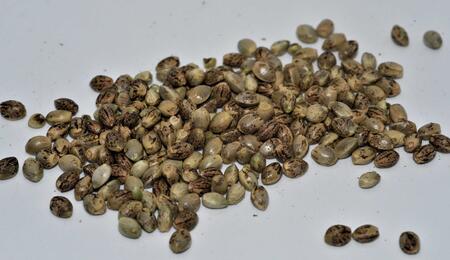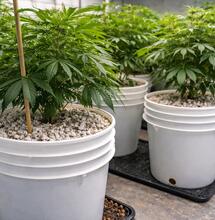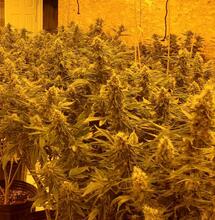A Beginner’s Guide to Germinating Cannabis Seeds

There is no better moment than when your new pack of Cannabis seeds arrives in the post. As you tear the pack open and think about all the wonderful things about to come out of this pack, it is worth considering the different ways to germinate. In this article, we cover three different methods, nutrients for seedlings, and the different types of seeds available.
The Different Types of Cannabis Seeds
There will be two types of Cannabis seeds that are available to grow, and these are regular sex or feminized. Originally, the only seeds that were available to buy were regular, and it was in late 1999 when the first feminized seeds rolled out and changed the indoor and outdoor marketplace forever.
Regular seeds
- These seeds will produce either male or female Cannabis plants
- Male plants would need to be removed from the garden during 12/12
- Regular sex seeds are much cheaper to buy than feminized.
- For breeding projects and stability, regular sex seeds are most practical.
Feminized seeds
- Only female plants will grow, meaning no need to remove males.
- The choice of feminized seed is much greater than regular seeds.
- A grower can use their indoor and outdoor space as efficiently as possible.
- It is possible to grow different feminized strains together, meaning more variety.
- Feminized seeds can be purchased as 3,5, and 10 packs.
The Different Methods of Germinating
Every grower has their preferences when it comes to seed germination. Some have used the same technique for decades, whilst others are still experimenting with other ways. Generally, a seed will pop out a small white tail within 48-72 hours once in any of the following environments.

1. Using paper towels
Using paper towels is easy and requires a piece or two of kitchen roll and two plates. The paper towel is folded up into a square and then the seedlings placed inside the tissue. The plates will keep the wet tissue paper moist, without the concern of drying out. As the seeds are sat on a wet tissue blanket and surrounded by air, it does not take long for signs of germination. In some cases, the roots can grow quite fast and may end up becoming longer than you originally anticipated, and worst case will make a J shape.
Top Tip: Make sure that the paper towel you are using is thick and easy to peel back and examine. Avoid cheap tissue paper that will become soggy and waterlogged. Remember, it is the air around the seeds that promote the roots to search outwards.
2. A glass of water
Throwing your seeds into a glass of bottled water and left in a cool and dark place, is another way to kick-start life. The seeds may float on the water for the first 12-24 hours, however once encouraged by a gentle swirl will all sink to the bottom of the glass. Some growers have no problems at all using tap water, others prefer store bought bottled water, and then others may add a few drops of 3% food grade hydrogen peroxide into the glass of water.
Top Tip: It is a good idea to change the water every 24 hours, and do not let the water come into contact with sunlight. In the event that seeds do not sink to the bottom, and show no signs of doing much, then be prepared to throw that seed out, if you cannot place it into soil and hope for the best.
3. Planting directly into soil
Mother Nature’s way and oftentimes the most practical, especially if you are confident that the growing medium you have is rich in nutrients. Cannabis seeds that come into contact with microbe and fungi rich mediums will grow faster and stronger than without. When planting your seedlings, you will want to take a match stick and insert 2 cm deep. The part of the Cannabis seeds that has a clear, round appearance needs to face upwards. The tap root will grow out and anchor itself downwards, and the seedling will emerge at the surface within 3-5 days.
Top Tip: Take extra care when inserting seedlings into your growing medium, making sure they are all facing the correct way. Seeds that form a J root can be problematic and produce stunted plants.
Nutrition and watering
Once all of your seeds have made it out of the substrate they are growing in, now you will need to feed them. At this very early stage, all you have to give them is plain water, with a minimal amount of nutrients.
Root boosters work well and if you are growing in soil, then using only water for the first 3-4 weeks is fine. Foliar spraying is an excellent way to keep the seedlings well hydrated, without transpiring too much. It is a good idea to frequently spray your seedlings, and to make sure they are as happy and healthy as possible.
Watering frequency, whilst plants are so young, is down to how often the growing medium becomes dry. Allowing the medium to fully dry out is actually a good thing for roots, and encourages them to search out into the open space. Finding the point between dry and light, to wet with runoff is a balancing act, but remember less is more when working with Cannabis seedlings.
What About Seeds That Don’t Germinate?
There is nothing more frustrating than when a pack of expensive seeds simply don’t germinate. Occasionally, the seedlings can look immature and pale colored, whilst others look the part, but just don’t do anything under any circumstances. Unfortunately, the quality control for many breeders is not what it used to be, but this is also how you learn which seed banks take pride in their work, and which are white-label specialists who only care about profits.
Avoid Using Bad Quality Soil
Don’t make a big mistake and start your seedlings off in poor quality soil. You will only be kicking yourself when they don’t germinate or have become waterlogged due to poor aeration and drainage. Below is a short list of what to look out for when inspecting soil.
- The texture is thick and clumpy and does not break apart easily.
- When watered, there is no runoff and the soil becomes very heavy
- When smelling a handful, there is a rotting egg aroma forming.
- There are no signs of perlite or anything that adds air pockets
- The soil has been used before and is full of chemicals.
Endo Mycorrhizae and Trichiderma
Did you know that at a microscopic level, millions of beneficial microorganisms exist in the soil? Bacteria and fungi work harmonizing with plants to allow them to access the soil food web. Endo mycorrhizae and Trichderma both have beneficial properties for seedlings or mature plants.
It is a good idea to mix beneficial microorganisms into your growing medium, to guarantee they have the best start in life, and are well protected from pathogens and diseases that may enter the garden and soil.





